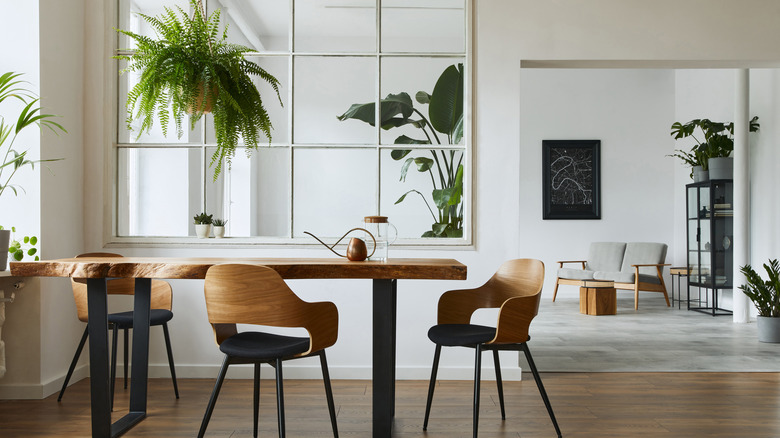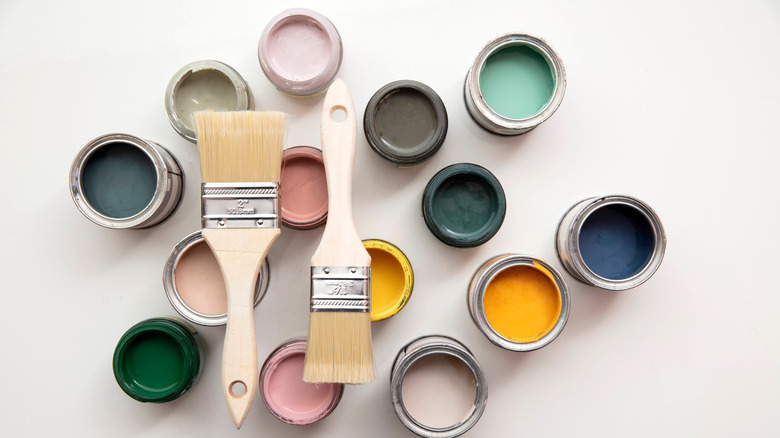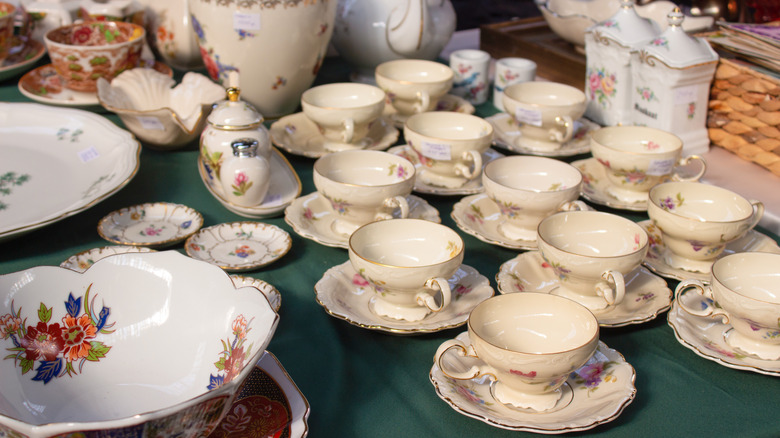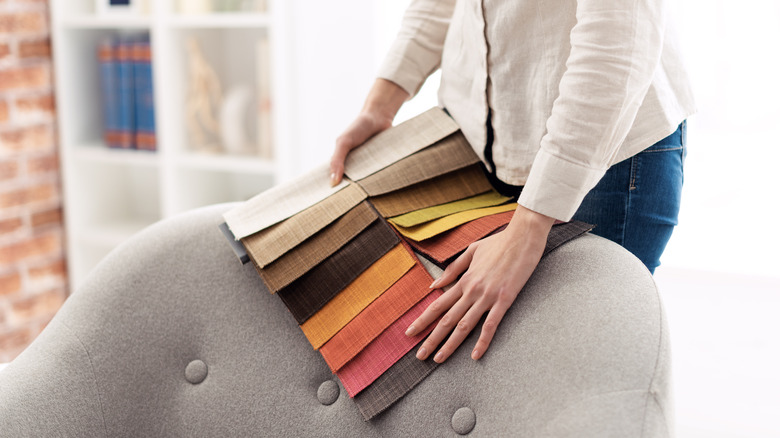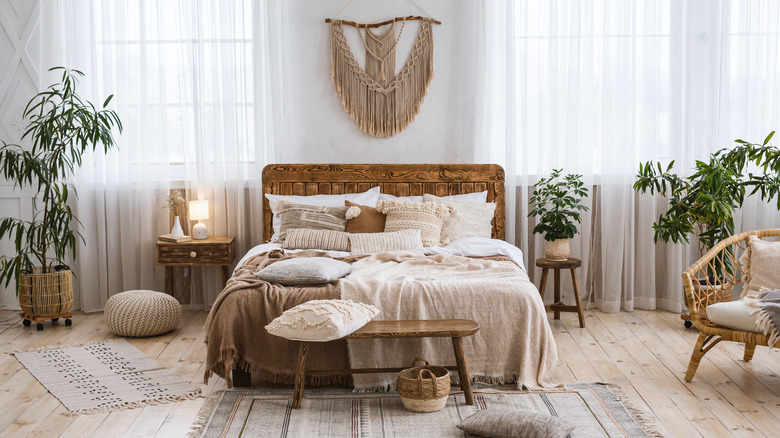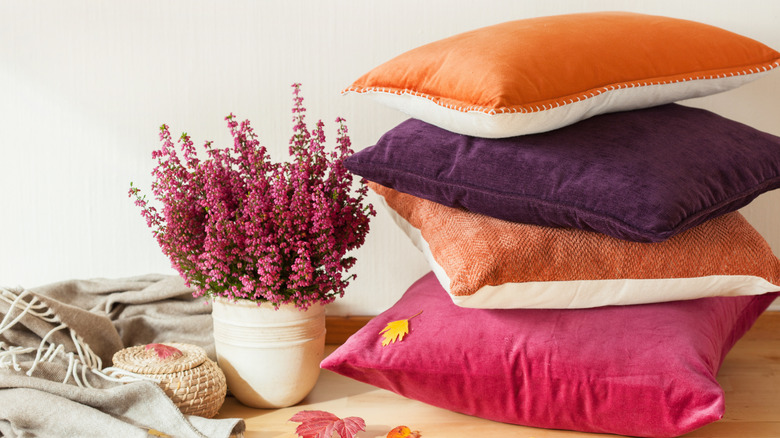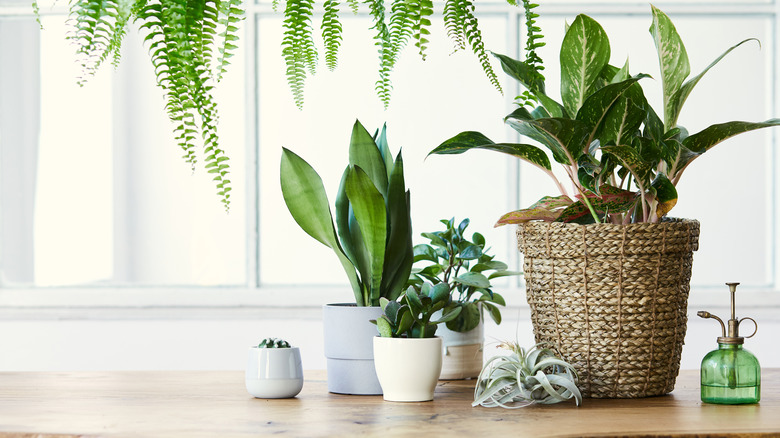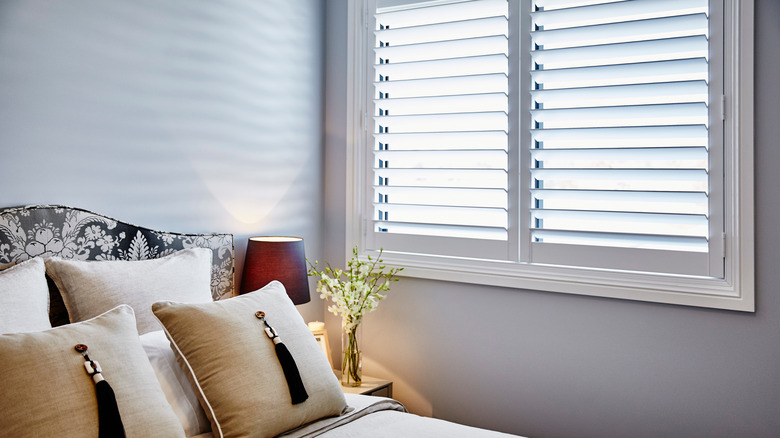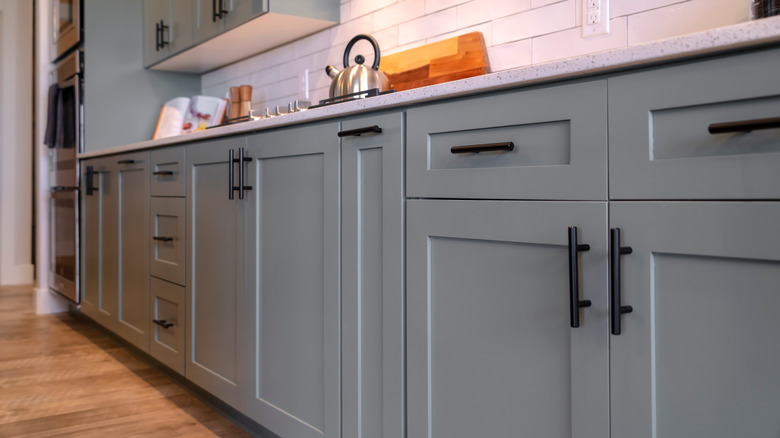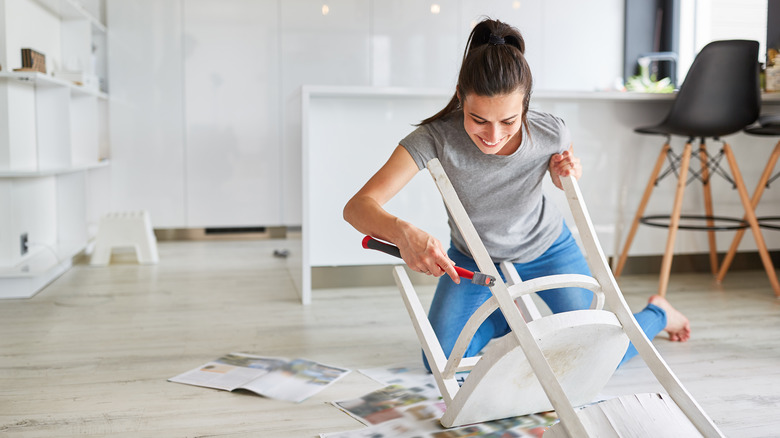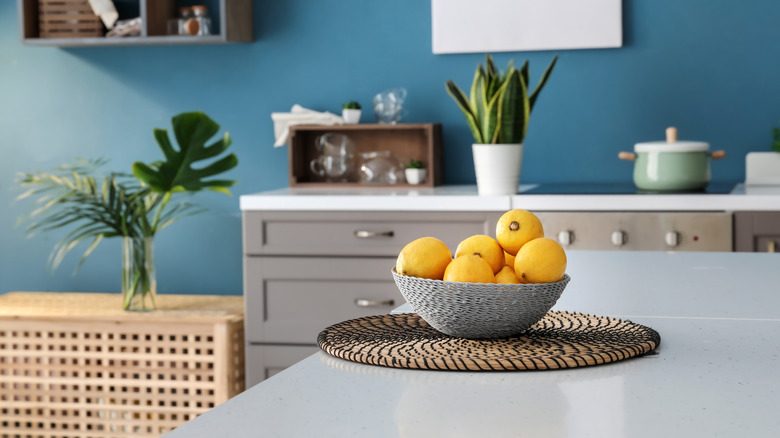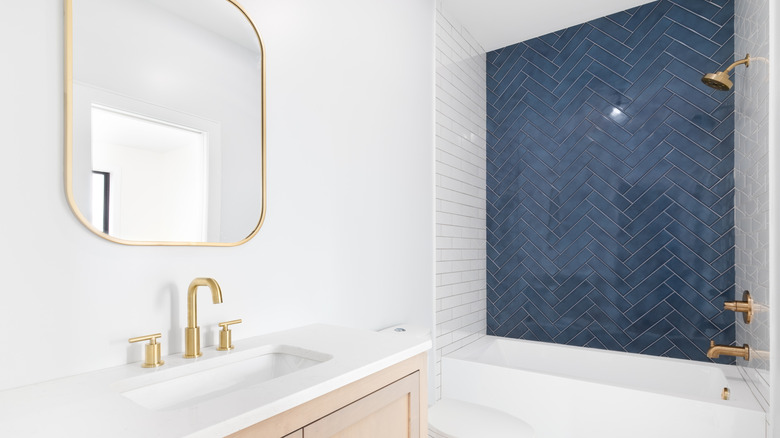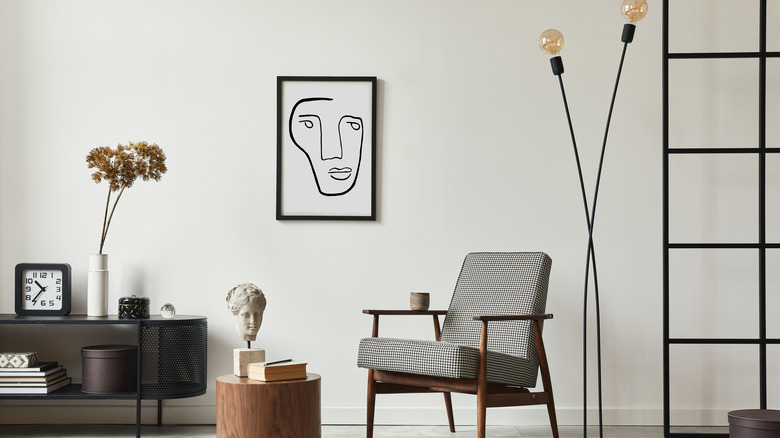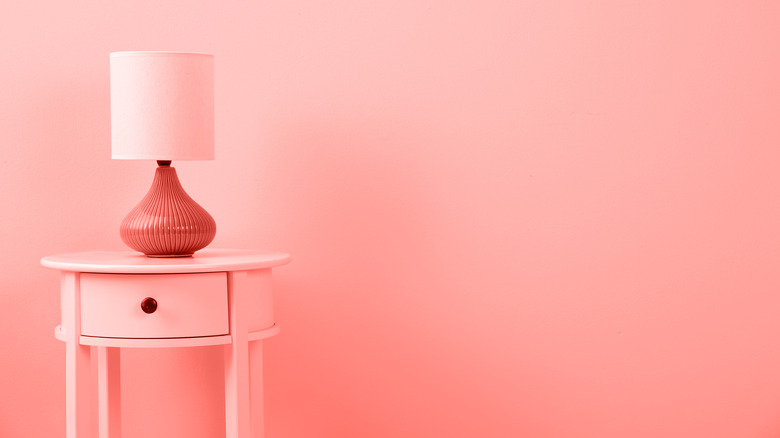How To Decorate Your Home On A Budget
Let's face it, there are very few of us out there that don't crave our dream home. While property ownership is more often than not a series of compromises, once we're in the place we call home, we want to make it our own and incorporate those personal touches and changes that make a house truly special. And, unfortunately, a lot of the time, these touches and changes come at a sky-high cost. According to Houzz, the average spend on a home renovation project in 2019 was a meaty $13,000, and if you can believe it, that's on the low end of the scale when it comes to a home revamp. Enlist the help of an interior designer to redesign your spaces and you could be looking at anywhere from $30,000 to $45,000, according to a breakdown calculated by StampinFool.com.
But before you give up on your home design dreams forever, take heart: There are a huge number of tricks and methods out there to decorate your home at a fraction of these costs, and will still have you end up with spaces that pop with life and style. Let's take a look at some of our favorite, budget-friendly design moves for your home.
Begin by decluttering your space
One of the best things that you can do to completely revamp a space is also something that's totally free. As interior designer Young Huh states to Real Simple, when you're embarking on a home decoration journey, "start by getting rid of clutter." By clearing out your space and creating room and openness, you not only have more to work with, but you also invite a sense of minimalism and order into your home, something which Huh recommends through trying to limit visible clutter. "Keep your surface areas neat and display a piece of art and some flowers," she advises.
And for those things that you can't quite throw out, Huh suggests styling "your bookshelves by arranging books and integrating art, boxes, and mementos." Some spaces, like bedrooms, can be trickier to declutter and maintain a sense of order. But in actual fact, keeping on top of your bedroom is far easier than you think, with House Beautiful recommending various different ways to keep your sleeping space sparkling. This includes a deceptively simple tip from professional declutter expert at A Tidy Mind, and the Association of Professional Declutterers and Organizers board member (now there's an organization we want to join!), Kate Ibbotson. "Get into good habits such as putting clothes away each night and laying out the next day's clothes," Ibbotson states. "It can make a huge difference to how you start the day in the morning."
Paint is your friend
One of the most effective ways to completely revamp a space is also the most effective: Giving your home a new lick of paint can change up a room at a fraction of the cost of buying new furniture or investing in remodeling work.
And what's more, not only is painting cheap and easy to do, but there are further ways that you can keep down the costs of a painting job once you decide on it, according to Real Simple. For example, there's absolutely no reason to rush out and buy new paint supplies when your old ones will do after a quick clean (you can even borrow your neighbors if you're on good terms). Calculating your wall space, and therefore how much paint you'll actually need, can help you make further savings — there are few things more annoying than ending up with a load of leftover paint that you have to throw out.
Where it does pay to spend a little extra, however, is in paint quality. As Real Simple says, lower-quality paints are generally thinner and will need way more to cover a wall properly, and you may end up with an effect that just looks a little cheap.
Get thrifty
Now, look. We love modern furniture. Don't get us wrong. Now that we've got that out of the way, let us extol our love for flooding your house with vintage items from a thrift store, which not only make your house feel totally unique and special, but will also help you decorate your space at a fraction of the cost of buying new.
In fact, it's a practice that Taylor Spellman, creative director and CEO of Taylor Spellman New York, swears by. "It is always exciting to find a showpiece for someone's home that I can guarantee they will not have seen anywhere else — and the price is right," he explained to Insider. Spellman suggests, in particular, keeping an eye out for items like pottery or antique china, which can give your home a touch of class and individuality without breaking the bank. "Whether it is priced to sell on the shelves or requires a little bit of negotiation, the price point is always way less than if I was to purchase the item in a high-end or brand-name store."
Think about reupholstering
If you have a piece of old, tired-looking furniture, there's no need to throw it out and buy a new one. Oftentimes, getting furnishings reupholstered can make your sofas and chairs look brand-new without having to break the bank. "Reupholstering a low-end piece in more luxurious fabric will cost significantly less than paying for premium furniture," states Anthony Stransky of Anthony Charles Interiors to Insider.
Whether you're reusing the frame of your old armchair and giving it a new lease of life or invigorating a sofa that you picked up on the cheap (Real Homes recommends sprucing up cheap sofas with velvet, for example), reupholstering could save you big bucks. Bear in mind, though, that reupholstery is not for the faint of heart — it's a big job that takes a lot of work, particularly for bigger pieces; without skill, you could end up with a mess on your hands. For this reason, it's maybe best left to the professionals. Fortunately, it can cost as little as $600 a couch, according to Home Advisor, with an average cost of $1,750 — still probably less than dropping your life savings on a sofa.
Change it up with what you have
When we think of redecorating, we automatically assume that we're going to have to buy lots of stuff. But frankly, "shopping" your own home, by assessing what you already have and how it could work in different configurations, is one of the best ways to refresh your spaces without having to spend any money — and interior designers are big fans. Heather Eubanks, The Design Collaborative co-owner, recommends starting with your bigger items. "Stand back and look at your anchor pieces first — large furniture items and rugs — then move on to smaller accessory items like side tables and last ancillary items like artwork and final touches," she shared in a chat with Apartment Therapy.
By tweaking your layout of breaking up sets of furniture, as designer Sabrina Soto suggests, you're able to create new-feeling spaces while using the resources that you have. You can also create new spaces entirely, says designer Jeremiah Brent, through thinking cannily about how your layout can be reconfigured. "Think of your house as a series of family moments and design those new areas with what you already have in your house," says Brent, who created a reading nook in his own family's home, simply by repurposing and rejigging.
Don't underestimate the power of a good throw pillow
We might be slightly biased here at House Digest, but we're a big fan of a throw pillow. And to be honest, we think we (and a lot of other folks) are onto something with them, with throw pillows acting as an incredibly effective, low-cost way of redecorating a space. As My Domaine states, a well-chosen throw pillow can accentuate a space's design features and make each room an event. And the best part is, once you master a few rules, the world's your oyster. Beginning with an anchor color to work around with your pillows allows a space to feel much more cohesive and well-thought-out, and keeping an eye on symmetry gives your design choices a sense of cohesion.
Not that you have to be too strict about it, though — playing with different shapes, proportions, and patterns are all part of the fun of throw pillows. Additionally, going for a more casual and "using what you find" approach can help your home feel much more lived in. If you're not sure where to start with throw pillows, Architectural Digest has the lowdown on some of their favorites, with reasonable options available at Target, as well as more bespoke options.
Get green
A lot has been written about the millennial obsession with houseplants, but the fact of the matter is, a little greenery in a home can go a long way. Picking up some house plants, which can normally be found for a few bucks a pop, is an excellent way of adding some low-cost elegance to your interior spaces. It doesn't have to be just potted calatheas and money plants, either; as The Spruce suggests, decorating your interiors with vines can be a brilliant way to spread color throughout a space or frame mirrors or doorways.
Plants can also be used to highlight a feature in your home to make it pop with vibrancy, like adding them to a bar cart or a hutch to make them statement pieces. And the great thing about plants most of the time is your spaces don't just benefit from the new green pals in situ, but from the pots they come in, which can be design choices in themselves. Terracotta and wicker pots can bring distinct feels to a space, helping to accent a room cost-effectively.
Keep it neutral
To decorate on a budget, it pays to start simple. And when we stay start, we mean the bare bones of your room. By keeping the base of your décor simple, with a neutral color palette comprised of beige, ivory, grey, taupe, or black, you're able to create what The Spruce describes as a bare canvas for your decorating choices. What this means, therefore, is that you can keep your décor choices adaptable and changeable, being able to change up the design of your space with ease, and not have to fork out a load of cash to repaint your walls or change your furniture when you feel like making a change.
But, we hear you cry, aren't neutral tones just a little bit boring? Well, friends, it's all what you make of them. According to Style by Emily Henderson, a canny way to create a neutral space is to use a mix of neutral shades, combining whites, greys, and other neutral tones to create subtle color variations. Adding in a pop of a contrasting neutral tone, such as a black or metallic moment in an otherwise light room, can also help to give a space definition, and allow you to layer less expensive style statements on top.
Change up your handles
One quick, easy, and incredibly cheap way to shift the feeling in a space is to make small but significant changes. This can start in places you might not think of, according to Wayfair's Resident Style Advisor Nadia McOwan-Hill. "Save money by buying inexpensive, neutral furniture pieces (like chest of drawers, headboards and coffee tables), secondhand shopping or by collecting family hand-me-downs — these basic pieces are the perfect canvases for DIY decoration," she told Ideal Home. Once you've done this, you can "make these pieces your own with decorative knobs," shifting out boring old drawer handles for something with a little more life and personality.
McOwan-Hill also recommends revolutionizing boring pieces of furniture with "patterned wallpaper or paint in your favorite shade." And you need not buy movable pieces to change up handles — take a look at your kitchen cabinets, for example. Could you try something different with the pulls to make your cooking space feel a little more unique? A simple change like this can make a space feel brand-new, at a fraction of the cost of new fixtures.
Repainting furniture can give it a new lease on life
When old wooden furniture starts to fade and fray, a lot of people say to themselves "well, out with the old, in with the new!" and throw it out without a second thought. But doing so is not only wasteful, but also forgets that repainting furniture is a budget-friendly way of bringing it back to life.
However, while painting furniture isn't exactly super-difficult, as with all DIY jobs there's a right way and a wrong way to go about it — and to stop your brand-new paint from flaking away within weeks, a little work is needed. As Country Living states, begin by sanding down your objects, even if you're working with a paint that claims that you don't need to. You're only looking to create texture on the furniture so the paint can adhere to it, so no need to go overboard. Using a primer before you apply the paint is an excellent way to ensure a long-lasting finish, particularly if you're working with laminate furniture. When you're finished painting, top the job off with a coat of protective finish, to make sure your new piece lasts a lifetime.
Accessorizing can make a space pop
Never underestimate the power of accessorizing. As with outfits, accessorizing a space can change it up significantly without breaking the bank, and it's easy and fun to do. As The Spruce states, your living room can be easily accessorized with items found at second-hand stores, things that you make yourself, or simply by bringing things that you already own out to display for all to see. You could also try hosting an "accessories party," where everyone brings items they've grown tired of to swap with others. Everyone wins!
Another suggestion from The Spruce is to accessorize with natural items, which allow you to continually change a space without having to spend loads of money on bespoke pieces. Items like tall sticks or pinecones can be collected and displayed tastefully in vases. Or, you could do what designer and antique store owner Kim Fiscus does, and place things like "orange tulips or a big bushel of pomegranates" in eye-catching places, per House Beautiful. Displaying fruit also has one extra benefit ... you get to eat it. That's a definite plus in our book.
Create an accent wall
If you're revamping a space, there's no need to change everything. Sometimes, creating new effects in a room can be easily and cheaply done through contrast, as is the case when creating an accent wall. When making an accent wall (a wall, or section of a wall, that stands out from the rest), you're in charge — you can be as bold or as subtle as you wish, and creating one can be as simple as grabbing a can of paint and a brush, states The Spruce.
Accent walls work excellently in neutral rooms, where they create an eye-catching dynamism in the space. While you might be tempted to keep things subtle, going bold is a great choice that can make your home décor stand out. So, don't be afraid of adding textures or patterns to an accent wall, as the only limit is your imagination and your tastes. And remember, you don't have to paint an entire wall to get a stand-out effect. You can create accents along strips or sections of walls, or paint a corner to make the sense of a new space in your existing room.
Get smart about art
It's easy to get bogged down with the expectation that any art displayed in your house needs to be high-end. But realistically, not all of us can afford an original Van Gogh — and nor should we need to. Learning how to find a solid deal on unique art pieces can make your space one-of-a-kind on a shoestring budget. Interior designer James Wheeler suggests "contacting your local college art program to see if there are any upcoming student art shows where you can purchase pieces inexpensively," via Real Simple. Not only will you save your pennies and get access to totally original art pieces, as Wheeler says, but you'll also pleasingly engage with your local community and create relationships.
You can also hunt for art or artists online (per Homes To Love), either through local community groups or through platforms like Instagram, to find artwork that'll work in your home. Remember, there's no right or wrong when it comes to displaying art — you don't have to limit yourself to paintings or photographs. Test the water and try out that sculpture you saw at a local art fair, but were unsure about buying. You might just find that it's the thing that everyone wants to talk about when they come round for dinner.
Your lampshades do more than you think
It's easy to underestimate the power of a lampshade. But these shades do more than just cast a tasteful glow — they also add style and statement to your spaces. For this reason, we'd recommend not settling for the basic lampshade that your lighting features come with. Lampshades can be mixed up, replaced, or made even more appealing through décor choices, and all of these options are pretty cost-effective. You can even refurbish your old lampshades to give them a new lease on life — try stenciling them, augmenting them with buttons or old wallpaper, or add stitching to create something totally unique, as The Spruce suggests.
And it's not just the lampshades of your lamps that make your spaces pop. You can make intelligent lighting choices in a room to completely change the feel of it, or make it seem even bigger than it is, according to Pooky. By spreading light sources through a room, or using mirrors or lights to reflect light, you can engineer a sense of spaciousness. Or, if you have a room that's taller than it is wide, try using long-hanging lamps to give a feeling of vertical space.
